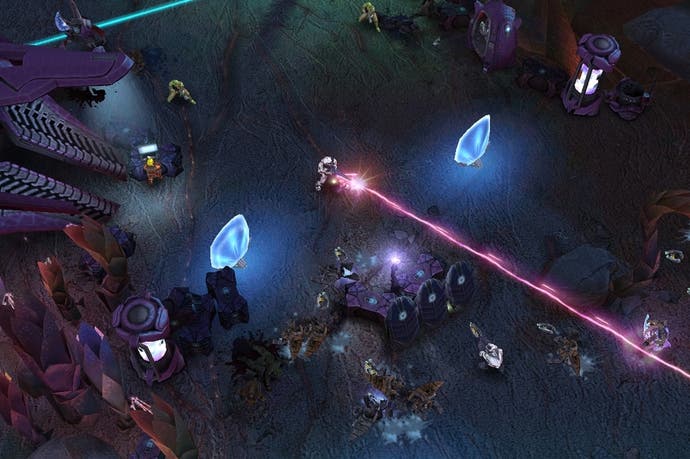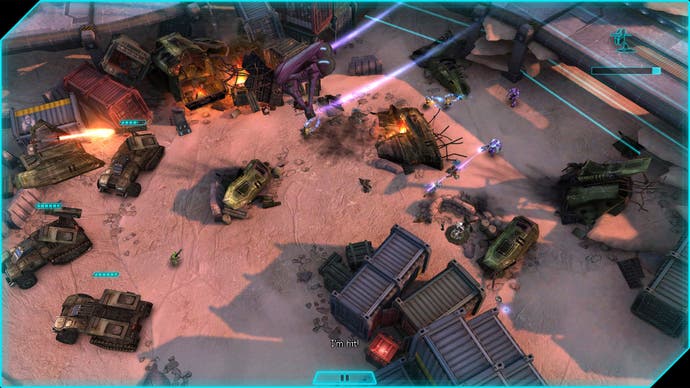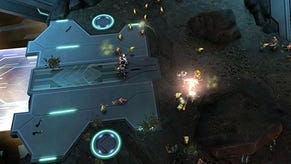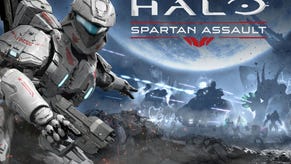Halo: Spartan Assault review
Spartan is such sweet sorrow.
The Halo series is surprisingly well-suited for life as a twin-stick shooter. After all, part of the fun of the Spartan existence is knowing that you'll be tackling overwhelming odds - and that you'll be encouraged to ad lib and rely on the occasional moment of dumb luck as you manage the hordes surrounding you. It's hardly a shock, then, that Halo: Spartan Assault turns out to be an entertaining, if fairly throwaway, top-down blaster. Grunts flock and scatter, Elites hang back before charging and, while those famous jumping skills are MIA, most of your other supersoldier abilities have made the transition from first-person shooters intact.
Spartan Assault plays out as a series of historical missions culled from a UNSC training simulator and, conceit aside, it's business as usual. Switching between two different Spartans, it's your job to see off an invasion from a splinter sect of the Covenant who are moving in on a buried Forerunner artefact. The lore's on point, but Microsoft's made the controls a little more of a mess than they should be. On Surface and Windows 8 phones, you've got standard floating virtual thumbsticks and buttons aided by a gentle lock-on. It's a little fiddly at first on the former - and it might be a bit of a squish on the latter - yet this is probably the best way of approaching an imperfect situation.
On Windows 8 PC, however, players are left to move with WASD and aim with the mouse, while gamepad support is promised in the near future. The current set-up turns out to be acceptable for everything except steering bigger, slower vehicles like the Scorpion tank, which always seems to want to travel in a diagonal line that requires holding down two keys at once. Other PC titles have sometimes opted for this sort of thing too, of course, but, with Microsoft handling the publishing, Spartan Assault really shouldn't have launched like this - and it won't truly feel like a proper twin-stick until the pad has been patched in.

Given time to acclimatise, though, you'll discover a fair amount of Halo DNA has survived the journey between perspectives. The magical triumvirate of gun, grenade, and melee continues to work a treat, and the same old rhythm of ducking in and out of combat as your shield dictates still gives even the blandest of mission objectives a satisfying sense of ebb and flow.
The series' bold use of colour is evident, too, allowing the campaign's five acts to unfold across a series of landscapes stained turquoise, amber, and purple. Textures are high quality and standard Halo enemies and weapons turn out to be readable and distinct from the new vantage point. While your improved freedom of movement and aiming makes the occasional item a touch over-powered - I'm inevitably talking about the needler - encounters are varied enough to keep you switching kit and improvising regardless.

Amidst the clutter of familiar enemies and hardware, the 25 bite-sized stages do their best to mix things up a little, too: lead three snipers to their nests, destroy five cannons, fend off attackers while an engineer does something clever. Dreaded escort missions turn out to be relatively painless, and the simplest ideas are often the best. A turret and an endless stream of baddies to mow down as you defend a queue of evacuees provides wonderfully brainless fun towards the end of the adventure, and, as with the main games in the series, the option to gad about in vehicles confers a welcome sense of freedom, even if the Scorpion's a pig to drive and the Warthog has been left in Master Chief's garage. There's always the Covenant's motors, eh?
The obvious level of care makes it all the stranger that, throughout proceedings, there are a series of low-level annoyances that will stick with you even when you've learned to enjoy the controls and adjust to this fresh approach to UNSC warfare. On the PC you'll get occasional audio glitches which see weapon sounds dropping out for a few seconds, while Surface players will take a little hit to the frame-rate. Then there's the AI, which only seems to spring to life a few seconds after you turn up, and drifts off again when you're out of range. This allows for some easy - if slightly guilt-riddled - assassinations in quieter levels, but it also makes for a very occasional moment when idiot comrades who are meant to be following you will forget what they're doing entirely.
On top of all that, a range of micro-transactions have been poorly applied to your loadout selection. Some alternate weapons and armour abilities can be paid for with the XP you accrue while playing. Others rely on credits, which have to be bought separately, which is irritating, as ever, in a game you've already ostensibly paid for.
These issues aside, Vanguard's created a decent blaster which offers a couple of moments of genuine bullet-dodging glory: Halo's touch-screen debut is good-looking, colourful, and fun. It's all rather bittersweet, really. If Spartan Assault was terrible, nobody would ever have to know about it, since the combination of release platforms makes it a bit of a curio from the off. In the end, it's actually pretty entertaining stuff. Here's hoping it eventually gets ported around a little.







